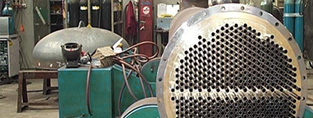
- (03) 5909 8218
- enquiry@fusionweld.com.au
Top 5 Primary Components of a Reliable Pressure Vessel
May 11, 2015

A plain description of a pressure vessel details the container as a shell and a handful of parts, which is a fine way of expressing this storage unit in easy to understand terms, but there comes the time to add a few fact-filling brush strokes to this explanation. Let's begin by elaborating on the primary components of a functional pressure vessel.
Common Shapes and Materials Used to Fabricate Pressure Vessels
Vintage pressure vessels were rolled from low-grade steel and riveted to a pair of circular end sections. Fast forward to today, an age where pressure vessels are welded to form a vast inventory of shapes. ASME guidelines dictate steel rolling techniques and the incorporation of additives that range from finite quantities of carbon to trace amounts of nickel and molybdenum, exotic metals that improve critical characteristics in the vessel. Shapes vary just as dramatically in this theatre of operation, changing to adapt to stored mediums. Look for the classic barrel shape, for semi-elliptical tanks, spheroids, cones, and other eccentric forms.
Manifold Connections
The header cross-section is the next component to receive due consideration, for pressure vessels are part of an enclosed system, a closed process that receives, stores, and dispels a pressurized fluid or gas. Intake and outlet nozzles are part of this classification, as are inspection plates and maintenance access points.
The Fitting of Active Trap Components
Depending on the application of a pressure vessel, any number of contaminants can be present. For example, a downstream petrochemical pressure vessel is filled with fractional fuels that may include catalyst leftovers. An array of specially fitted scale traps capture and separate this contaminant, leaving the purified form of the fuel to be stored in the main chamber of the vessel.
Plate and Shell Geometry
Since the shell of the pressure vessel is fabricated from rolled steel or some other exotic alloy, the geometry of the form naturally trends toward the simplest form, that of a sphere. Unfortunately, spherical constructs are harder to manufacture and more complex shapes are difficult to analyse. The sweet spot in this scenario is some variant of a cylinder. The design then incorporates a combination of plate and shell ends, before welding or bolting the panels onto the end of the rolled vessel. The eventual geometry appears as a bulbous cylinder with a thicker plate at one end, a purposefully reinforced panel that serves alongside the manifold connections as an access point.
Dynamic Additions to the Pressure Vessel Model
Flanged and welded headers are one thing, as are connection methodologies and manifold designs, but we would be remiss in not detailing other, safety-centric, functions of the reliable pressure vessel. Safety valves are an intrinsic part of the design, so as mathematically calculated engineering flanges that metallurgically assess thickness computations that assign the right grade of steel to the stored medium. These engineered assessments deal with everything from the simplest spherical storage unit to multi-chambered vessels that incorporate heat exchanger functions.
Contact Details
Fusion - Weld Engineering Pty Ltd
ABN 98 068 987619
1865 Frankston Flinders Road,
Hastings, VIC 3915
Ph: (03) 5909 8218
Optimized by NetwizardSEO.com.au
Recent Posts
- Compressed Hydrogen Storage Vessels: Material Selection, Design & Australian Standards
- Welding QA/QC in Oil & Gas Pressure Vessel Fabrication – Ensuring Code Compliance
- AS1210 vs ASME VIII Pressure Vessel Code: Key Differences for Australian Projects
- Mitigating Hydrogen-Induced Cracking in Pressure Vessels: Engineering and Material Strategies
- Storage Tank Solutions Australia: Field-Erected, Prefabricated & Self-Bunded Explained
- Reducing Environmental Risks: Self-Bunded Tanks in Australian Oil & Gas Operations
- Precision in Production: How Pressure Vessels Are Manufactured for Industrial Safety
- Shell & Tube Heat Exchangers: Improve Thermal Control & Energy Recovery in Petrochemical & Pharmaceutical Plants
- In-Service Inspection for Compressed Air Receivers for Power Plant Shutdown Prevention
- Power Plant Pipe Spooling Fabrication – Get Rapid, Code-Compliant Spools Ready for Installation
- Field Erected Tanks: Safe, Reliable On-Site Fuel Storage Solutions in Australia
- Custom Pressure Vessel Fabrication for Flammable Gases
Posts 2025
- Compressed Hydrogen Storage Vessels: Material Selection, Design & Australian Standards
- Welding QA/QC in Oil & Gas Pressure Vessel Fabrication – Ensuring Code Compliance
- View all articles…
Posts 2024
- Large Process Vessels: Optimising the Design for Maximum Efficiency [2025]
- Pressure Equipment Management System Installation: Detect Equipment Faults Early
- View all articles…
Posts 2023
- Pressure Piping System Inspection: A Gift of Safety for the Holidays
- Deaerator Inspections by Fusion-Weld Engineering and How They Reduce System Downtime
- View all articles…
Posts 2022
- How Fusion Weld Keeps Up With AS-NZS ISO 9001:2008 Standard
- Boiler Equipment Safety Inspection During the Summer Season
- View all articles…
Posts 2021
- Avoid These Factors and Practices that Contribute to Sealing Damage in Pressure Vessels
- Do's And Don'ts Of Industrial Boiler Inspection And Maintenance From Fusion-Weld
- View all articles…
Posts 2020
- What are the Risks and Hazards Involved in Pressure Vessel Equipment?
- How to Know if Your Pressure Equipment Needs Repair or Replacement?
- View all articles…
Posts 2019
- Factors that Contribute to Pressure Vessel Failure
- Pressure Vessel Regulations in Australia: What are the Mandatory Requirements?
- View all articles…
Posts 2018
- Pros and Cons of Spherical vs. Cylindrical Pressure Vessels
- What are the Different Hazard Levels in Pressure Vessels?
- View all articles…
Posts 2017
- Transportable Pressure Vessels: The Importance of Inspection and Safety Checks
- Fracture Mechanics and Stress Analysis of Cracks in Pressure Vessels
- View all articles…
Posts 2016
Posts 2015
- What Are Deaerators & Feedwater Vessels?
- Precautions and Safety for Compressed Air Receiver Vessels
- View all articles…
Posts 2014
- Demonstrating In-process Inspection Procedures
- Static Grounding Practices and Standards
- View all articles…